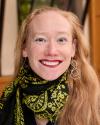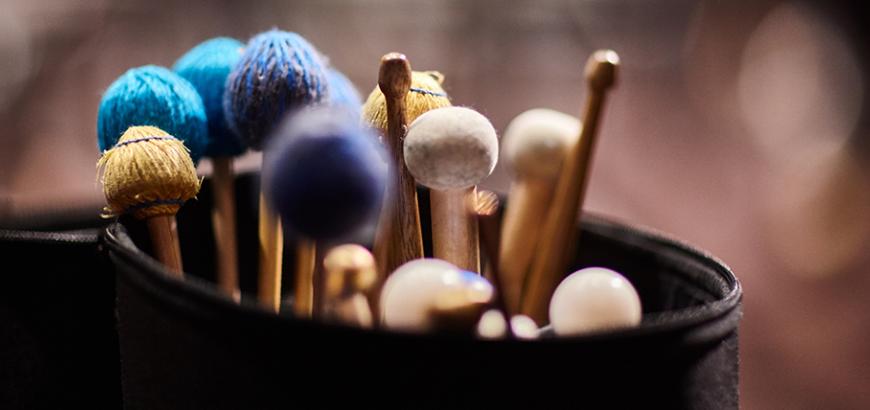Program
Wake for Charles Ives (1974/75): James Tenney (1934-2006)
Ionisation (1931): Edgard Varèse (1883-1965)
Crystal Canon for Edgard Varèse (1974-5): James Tenney
Mosaic (1975): Nicholas Hubbell (b. 1951)
Hocket for Henry Cowell (1974/75): James Tenney
Danza de los Saqsampillos (2006): Gabriela Lena Frank (b. 1972)
Rítmica no. 5 (1930): Amadeo Roldán (1900-1939)
Rítmica no. 6
Ionisation (1931): Edgard Varèse (1883-1965)
The UW Percussion Ensemble:
Ryan Baker, Kaisho Barnhill, Cyan Duong, Scott Farkas, Momoka Fukushima, Abigail George, Simon Harty, Taryn Marks, Rose Martin, Ivy Moore, Grace Rosing, Luigi Salvaggio, Melissa Wang, Nat Yamamoto
Program Notes
In February of 1931, Amadeo Roldán wrote a short note to his friend Edgard Varèse and then carefully packaged two sets of claves, a cowbell, a pair of maracas, a set of bongos, a guiro and scores for his Rítmicas 5 and 6. He sent this missive from Havana to Paris, where the French American composer was in the middle of his work on Ionisation, hailed at its premiere nine months later (incorrectly but consistently, even nearly a century on) as the first piece of notated music in the Eurocentric classical tradition for percussion ensemble. Roldan’s Rítmicas should have this distinction. These are short, exquisitely-crafted pieces devoted to the exploration and manipulation of rhythmic patterns indigenous to the composer’s Afrocuban culture. Roldán preserves a consistent pulse but deftly maneuvers a version of the son clave rhythm by breaking it up between players, superimposing it over various mixed-meter passages, and later presenting it in stretto. Furthermore, his notation from these first pieces persists; Varèse and later John Cage also wrote for maracas split between two hands, for example, and the practice of specifying beating spots and techniques in the preface to a percussion score comes directly from these earliest works. Roldán was a celebrated exponent of the Afrocubanismo movement, an aesthetic trend in Havana’s music, dance, literature, and visual art scenes tied to both the often-marginalized African cultural features in Cuban society and the vanguard of experimental expression. These Avant-Garde sensibilities connected Varèse and Roldán, and both were members of the Pan-American Association of Composers. Formed by musicians from Cuba, Mexico, Canada, and the United States, their stated objectives included cultivating a “. . .wider mutual appreciation of the music of the different republics of America, and stimulating composers to make still greater effort toward creating a distinctive music of the Western Hemisphere.” Percussion music was a logical focal point for these musicians (and other notable PAAC members, including Carlos Chávez, Henry Cowell, Charles Ives, and Ruth Crawford Seeger.) Between 1928 and 1934, the PAAC gave over 40 concerts that highlighted new and experimental musical resources with what they considered a distinctly American sound, crafting programs that were purposefully diverse and international.
The preeminence of percussion, the robust communication between members, and the advocacy for one another’s music were hallmarks of the PAAC that helped to shape experimental music throughout the Americas for decades to come. The rest of tonight’s program highlights similar references and connections. One of the recurrent themes of James Tenney's highly diverse musical output is an engagement with the work of other composers. In his Three Pieces for Drum Quartet (1974/5), this tribute to members of the PAAC goes beyond superficial connections, pointing instead to musical continuity. We’ll begin with his process piece, Wake for Charles Ives, follow Ionisation with an exploration of its primary theme in the Crystal Canon for Edgard Varèse, and perform an audience-immersive version of the Hocket for Henry Cowell. We’ll also present two marimba duets: Nicholas Hubbell’s minimalist Mosaic and Gabriela Lena Frank’s energetic Danza de los Saqsampillos. Delving into musical traditions from her Peruvian heritage, this duo is characterized in part by its sesquiáltera (literally, “changing sixes”); the juxtaposition of compound duple (6/8) and simple triple (3/4) meters.
The cowbell, guiro, maracas, and bongos from Roldán’s package in early 1931 made their way into the final score of Ionisation. A central premise of historical experimental percussion music from the early-to-mid 20thcentury was that this art was revolutionary because of the way it organized and included found and traditional sounds from various environments and cultures, allowing percussion to thrive as a contributive force in Eurocentric musical culture. Varèse wrote about individual sounds having “intelligence,” and their endless possibilities of expression, akin to a new “interplanetary” language. I believe that Varèse hoped these Afrocuban sounds would be re-contextualized both formally (when utilized here in the context of something akin to a traditional sonata form), and timbrally (when deployed alongside various snare and bass drums, resonant metals, and other sounds like the high and low sirens, the whip, or the anvils.) However, while Varèse created a stunningly fresh sonic landscape, especially through the ways in which he managed blocks of sound and resonance in layered variation, this work remains a product of both musical and cultural memory. Ionisation’s anvils (embodying the hammering sounds of a cityscape while also quoting Das Rheingold) and its Afrocuban percussion instruments (punctuating rhythms divorced from traditional clave and rumba, but still resounding with the vibrant sounds of their original context) might not constitute revolution, but they do point to exciting futures for percussion when heard alongside other works like the Ritmicas and experienced in the spirit of the Pan American Association of Composers. We’ll play Ionisation twice tonight, not because I’d like to further solidify its primacy, but because this is a way to truly hear the connections between it and the concurrent/following pieces. It has been a gift to hear this piece in the context of the ideas that preceded and proceeded it.
-Bonnie Whiting
Acknowledgements
Many thanks to: the graduate student ensemble coaches (Rose Martin and Scott Farkas), our student workers (Kaisho Barnhill and Scott Farkas) the Meany Center staff, the UW School of Music Staff and our Director Joël-François Durand.
The University of Washington acknowledges the Coast Salish peoples of this land, the land which touches the shared waters of all tribes and bands within the Suquamish, Tulalip and Muckleshoot nations.
Biography

Bonnie Whiting (she/her) performs, commissions, and composes new experimental music for percussion. She seeks out projects involving the speaking percussionist, non-traditional notation, improvisation, and interdisciplinary performance. Her debut album, featuring an original solo-simultaneous realization of John Cage's 45' for a speaker and 27'10.554” for a percussionist, was released by Mode Records in April 2017. Her sophomore album Perishable Structures, launched by New Focus Recordings in 2020, places the speaking percussionist in the context of storytelling and features her own music as well as works by Vinko Globokar, Frederic Rzewski, Richard Logan-Greene, and Susan Parenti.
Her recent season highlights include onstage work in the multimedia chamber opera The Ritual of Breath Is the Rite to Resist, featuring productions at Lincoln Center’s Summer for the City, at The Hopkins Center at Dartmouth College, and at Stanford Live; a reprise of composer Wang Lu’s Stages for solo speaking/singing percussionist at New York’s Performance Spaces for the 21st Century (PS21); and four performances of a new concerto written for her by Jonathan Bingham with the National Symphony Orchestra for the family pops series at the Kennedy Center alongside renowned children’s book author Mo Willems. Whiting also creates original, improvised music with clarinetist James Falzone and pianist Lisa Cay Miller; their first album was released on Allos Documents in 2024, and the trio performs this season in Seattle, Vancouver, and Portland.
In 2022 she premiered Through the Eyes(s): an extractable cycle of nine pieces for speaking/singing percussionist collaboratively developed with composer Eliza Brown and ten artists and writers incarcerated at the Indiana Women’s Prison. The project was featured on NPR’s nationally-syndicated Slingshot, and locally via Seattle’s ClassicalKING radio station. Whiting has an ongoing relationship as a soloist with the National Orchestra of Turkmenistan via the U.S. Embassy Cultural Affairs Office, playing concerti in Ashgabat in 2017 and 2018. She performs frequently with percussionist Jennifer Torrence, giving concerts of new experimental work for speaking percussionists throughout Norway and the US. Her collaboration with multimedia artist Afroditi Psarra generated the album <null_abc>, released on the Zero Moon label in 2018, and their project with designer Audrey Desjardins on transcoding data from IoT devices as performance received a 2019/20 Mellon Creative Fellowship. The project was explored in a workshop at the 2020 Transmediale Festival in Berlin, and currently lives as an interactive net art installation. She spent four years performing music for voice and percussion with the Harry Partch Ensemble on the composer’s original instrumentarium while the instruments were in residence at the UW. Whiting has presented solo and small ensemble shows at The Stone in New York, the Brackish Series in Brooklyn, The Lilypad in Boston, The New York City Electroacoustic Music Festival, at Hallwalls in Buffalo, the Tiny Park Gallery in Austin, The Wulf in LA, the Carl Solway Gallery in Cincinnati, The Grove Haus in Indianapolis, on the Wayward Music Series in Seattle, on tour throughout New Zealand, and at colleges and universities around the country.
Whiting is the Co-Artistic Director and core percussionist of the Seattle Modern Orchestra, the Pacific Northwest’s only large ensemble solely dedicated to music of the 20th and 21st Centuries, and she plays vibraphone with the Torch Quartet. As a chamber musician, she has collaborated with many of today's leading new music groups, including red fish blue fish percussion group, (George Crumb's Winds of Destiny directed by Peter Sellars and featuring soprano Dawn Upshaw for the Ojai Festival), eighth blackbird (the “Tune-in” festival at the Park Avenue Armory), the International Contemporary Ensemble (on-stage featured percussionist/mover in Andriessen's epic Die Materie at the Park Avenue Armory, and the American premiere of James Dillon's Nine Rivers at Miller Theatre), Talea Ensemble (Time of Music Festival in Finland), Bang on a Can (Steve Reich's Music for 18 Musicians for the LA Philharmonic's Green Umbrella Series) and Ensemble Dal Niente (the Fromm Concerts at Harvard.) She attended Oberlin Conservatory (BM), the University of Cincinnati College-Conservatory of Music (MM), and the University of California San Diego (DMA). She is an Associate Professor of Music at the University of Washington, where she has been Chair of Percussion Studies since 2016.
